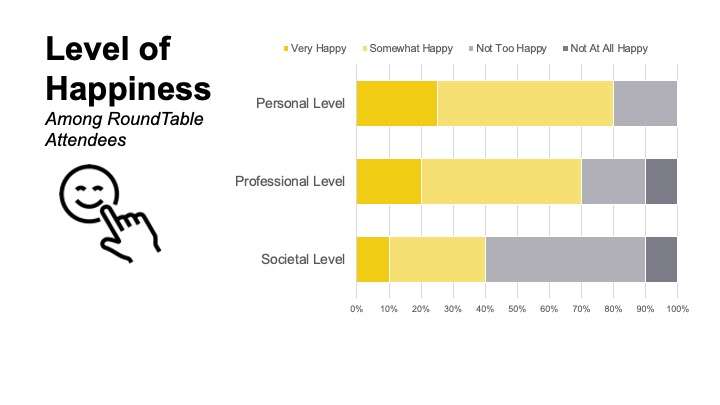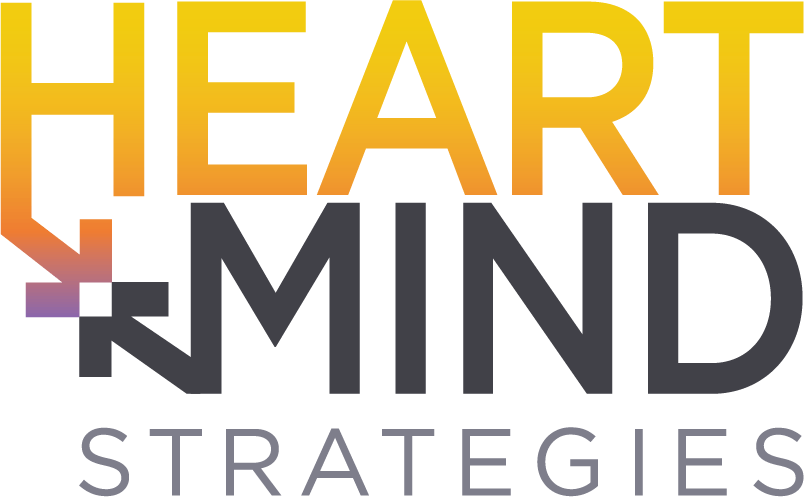When was the last time you reflected on your happiness outside of the sheer experience of happiness, just as an emotion, perhaps as an object? Observing emotions may be a familiar concept – often in relation to conversations about mindfulness and psychology; however, the actual practice of it might not be present in your life. Whether you’re a business leader or an intern, keep reading as we explore the tools that help create happiness in your personal, professional, and social life, as well as the importance of happiness in the workplace.
At Heart+Mind’s most recent RoundTable, we discussed the convergence of happiness and technology with three guest speakers: Chris Wasden of Happify Health, life coach and therapist Carrie Wrigley, LCSW, and our very own Chris Tonay of Heart+Mind. In this post, we’ll explore what happiness is and how we can create it in our life.
Happiness on Personal, Professional, and Societal Levels
On a personal level, we find happiness in the relationships with our loved ones, the fulfilment we find in hobbies, accomplishments at home, and experiences that enrich our lives. Conflicts at home, trouble with finances, and a lack of meaningful experiences can make it hard to enjoy life and makes happiness more elusive.
On a professional level, happiness is manifested when we receive recognition for our work, make meaningful advancements in our careers, and are in a space where we can experience fulfilment through the work we do. On the other hand, being happy is harder if you’re burning out (or already burnt out), not progressing in your career as much as you think you should, or work in a negative, or even toxic, environment.
On a societal level, we traditionally find happiness by volunteering, being a part of civil society, participating in activities that promote the wellbeing of your neighborhood, and seeing yourself as a member of a community. With changes in the media created and consumed (e.g., 24-hour news channels and social media), we can often find ourselves thinking we’re not in the society we want to be, participating less in our community, and spending more time consuming content mindlessly. These factors can make it more difficult to experience happiness.
We polled our RoundTable attendees on how happy they feel at each of these three levels. Although we wouldn’t take this sample as a reflection of society at large, there are some interesting takeaways from the results and the conversation around them. Just in the group of attendees we see that happiness is greatest at the personal level, and tends to diminish somewhat at the professional level, and even more so at the societal level.

Most of us have felt happy and unhappy at each level, and unhappiness in one area can often bleed into another area of our lives. During the RoundTable our guest speakers taught that happiness can be a mindful decision. That doesn’t mean that choosing to be happy will suddenly make you feel better. It means you have the ability to make changes in your life that will get you to feeling happy. With that in mind, let’s make happiness happen.
Happiness Through Mindfulness
When we’re engrossed in a difficult situation or with a challenging question, we’re often told to take a step back to evaluate it. You may have done this yourself, in which case, you’re already grasping the practice of mindfulness.
Chris Tonay, a Senior Solutions Director at Heart+Mind, shared his knowledge and experience as a long-time practitioner of mindfulness and meditation. A key feature of mindfulness is taking a step back to observe your internal states (e.g., thoughts, feelings, emotions). From there, Tonay encourages us to stop clinging onto both positive and negative thoughts. He shares that through this process, we begin to understand ourselves not as being sad, but rather recognizing that sadness is simply happening in a given moment.
He draws the following analogy:
“Thoughts are like clouds in the sky. Emotions are like clouds in the sky. They arise, they pass away. They come, they go. But at the end of the day, you are not your emotions. You are not your thoughts. You are the sky.”
Chris Tonay, Heart+Mind Strategies

By practicing mindfulness, you can begin to choose which emotions and thoughts to lean into or pull away from. If the cloud of anxiety is forming, remember to take a step back to consider it as an event you can lean into or let go. As you start to develop this skill, you will notice a change in the relationship between you and your mental states. You free yourself from being overwhelmed and governed by emotions, and instead you become in control of how you feel.
Positive Psychology and Tools
Now, you read this mindfulness advice and start becoming aware of your mental states, but you can’t quite see the cloud of happiness, perhaps you mostly see clouds of negative thoughts and feelings. What can you do? A lot actually!
Chris Wasden, Head of Corporate Strategy at Happify Health, shared how his company was founded on the principles of positive psychology. This is a branch of study that focuses on the wellbeing of the human on many levels. Research in the field has shown that happy people:
- Use positive words
- Engage with the world around them in meaningful ways
- May have transcendent experiences such as entering a state of flow, practicing mindfulness, and experiencing inspiration
- Don’t let accomplishments or achievements be diminished by comparison to others
Implementing the above tactics in your own life is taking a step towards creating happiness. We dive into these and other ideas in our post on the intersection of happiness and technology. Head over to that post when you’re done here to learn more.
RELATED: 4 Ways Technology Can Improve Happiness
Some practical applications of the research in positive psychology are tools therapists use to help patients. Presented straight from her latest book, Your Happiness Toolkit, Utah-based therapist Carrie Wrigley, LCSW, shared her tried and true tools for increasing personal happiness. She walked us through her 16 tools grouped into 3 categories of traits, skills and strategies.
Each tool is a semantic differential scale you use to identify where you lie in relation to two terms, one negative and the other positive. As you identify where you’re at on each scale, take a step back to consider how you feel about it. What can you do to get closer to the positive term? Moving towards the positive on some of these is difficult, but it can show you a path towards being happier.
INBORN TRAITS: Inborn traits are tools that are natural to us. Toddlers will show behavior which we can place throughout each scale, and in a similar way, we innately present them as we respond to the world around us.
- Inaction to Action
- Numbing to Feeling
- Negativity to Positivity
- Stagnation to Learning
- Consuming to Creativity
LEARNED SKILLS: Learned skills are those we acquire in early childhood, and continue to develop throughout our lives. These involve the world around us informing our lives, and us responding by interacting with it.
- Comparing to Identity
- Reactivity to Recording
- Distraction to Seeking
- Avoidance to Sociality
- Isolation to Service
ADVANCED STRATEGIES: Advanced strategies take practice, work, and self-awareness (being mindful). On our journey to happiness, we need intentionality to promote our long-term wellbeing. Wrigley emphasizes these are often difficult to work on and recommends working on the prior two categories as you build up to these.
- Illness to Health
- Inactivity to Activity
- Disorder to Order
- Triggering to Thinking
- Conflict to Connection
- Ignoring to Healing
RELATED: How Doing Good Can Strengthen You and Your Organization
Happiness and Business

Business leaders have a uniquely influential position in making the lives of their employees and co-workers happier. The environment and culture fostered by a company will affect the well-being of each employee. During our RoundTable, each guest spoke to their experience of happiness in the workplace. One of the difficult tasks for many companies is giving employees a “why” they can connect with. However, working towards a “why” a team can get behind can make all the difference in retaining employees.
For employees, making the workplace better might be a conversation with managers on what they want out of the job. It can be anything from more training and a change in schedule, to changes in management style and being provided clear instructions where possible. For some employees it might be a change in their role.
The shock to the labor and job market caused by the pandemic pushed many to consider a different path that would hopefully lead to a happier state of well-being. To retain good employees, managers need to facilitate the environment and benefits that best work for their team. As company culture and the work environment improve, other areas like productivity, sales, and quality of work will improve.
At Heart+Mind Strategies, we believe in people and the power of choice. As such, our team resonated with the message of choosing to create happiness. We’re a company with a lifer mentality that seeks to empower those we work with, from our own team to our clients, to learn, grow, and realize goals.
Watch full RoundTable session at the link below.
